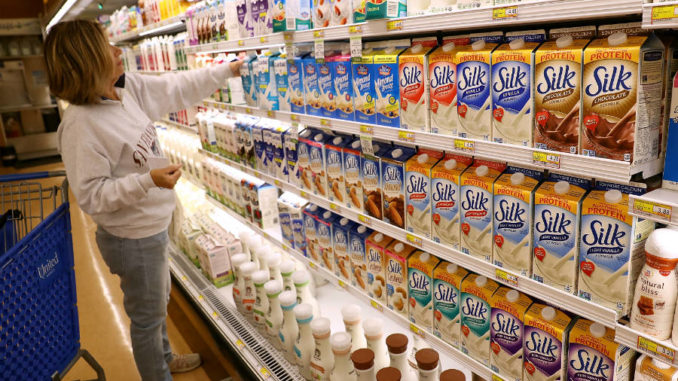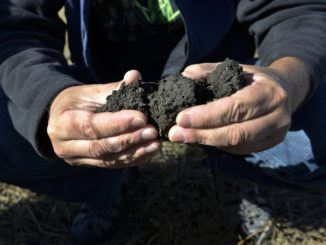
Cow’s milk producers want the government to block almond, soy and other competitors from being called milk. The plant-based milks are fighting over other titles.
BY GEORGINA GUSTIN
Walmart, the country’s largest food retailer, plans to begin selling a new chilled milk this month that bears the cutely clever brand name Milkadamia.
Made from macadamia nuts grown at the edge of the Australian rainforest, then processed into a paste, shipped to the U.S. and turned into milk at a plant near Chicago, Milkadamia is billing itself as a more sustainable, climate-friendly alternative to cow’s milk—and to almond milk, the non-dairy milk of the moment.
“We’re all about climate change,” said Jim Richards, Milkadamia’s CEO. “We’re telling the story of regenerative farming. We’re talking about micro-organisms in the soil and carbon sequestration.”
That narrative, Richards hopes, will resonate with consumers in an increasingly crowded non-dairy milk universe: Plant, grain and nut-based milks now make up 10 percent of the overall milk market, and Milkadamia has joined a growing range of alternative milks that are battling for space in American fridges. In their attempts to gain an edge with consumers, they’re not only highlighting their relatively low carbon footprint compared to dairy, they’re also trying to stake a claim as the most planet-friendly of all.
In addition to the biggies—the first breakthrough was soy milk, later overtaken by almond milk—there’s pea milk, coconut milk, hemp milk, cashew milk, quinoa milk, oat milk, rice milk. Sales of almond milk alone shot up 250 percent between 2011 and 2016. Meanwhile, consumption of dairy milk has plummeted 37 percent since the 1970s, according to the U.S. Department of Agriculture.
This boom—and decline—has spooked the dairy industry, prompting attack ads against “fake” milk and a campaign supporting legislation that requires regulators to enforce a standard that would prevent non-dairy milks from being called milk at all. At the annual meeting of the National Milk Producers Federation last fall, the group accused “fake food marketers” of exploiting the “nutritional halo” of dairy milk.
“Consumers can be misled that all milks are created equal, that they’ll have the same amount of nutrition,” said Chris Galen, a spokesman for the federation. “Why does it matter so much to the imitators? All the almond, quinoa, hemp, soy? They use the name ‘milk’? Why is that? Because they recognize there’s value, there’s brand equity in using a familiar term—a term that connotes a healthful halo.”
Infighting Over Sustainability—and Market Share
The dairy industry has, for years, come under scrutiny for its carbon footprint. Globally, the sector emits 4 percent of all human-caused emissions, mostly in the form of methane, an especially potent greenhouse gas. In the U.S., every gallon of milk consumed results in greenhouse gases equivalent to 17.6 pounds of carbon dioxide emissions. The numbers are so significant—enough, perhaps, to impact consumer choice—that the dairy industry announced a goal of cutting its greenhouse gas emissions 25 percent by 2020.
In the meantime, alternative milks are eating into market share. That’s good news for the plant-based food industry, of course. But it’s also prompted infighting as non-dairy competitors attempt to distinguish themselves in their 10 percent sliver of the marketplace.

Cow’s milk holds close to 90 percent of the milk market, but it’s been losing ground to almond milk and and other plant-based milks. Credit: Darren Hauck/Getty Images
Increasingly, one of those distinctions is sustainability—and Richards, for one, is unafraid of going after macadamia milk’s competitors on that front.
“If you’re going to talk about almonds—every one is on life support,” Richards said, referring to the huge amount of water required to grow almonds. “It should be the poster child of un-sustainability, along with dairy.”
What Do Consumers Want?
Consumers are choosing dairy alternatives, research finds, largely for health reasons and out of concerns for animal welfare.
“Environmental concerns are pretty far down the decision tree for the average consumer,” said Michele Simon, executive director of the Plant Based Foods Association, which includes manufacturers of vegan and vegetarian foods, including Tofurky and Daiya, along with big mainstream names like Campbell’s Soup.
But those concerns are starting to matter more, research shows.

A man processes soy beans into soy milk to make traditional desserts in Hong Kong. Credit: Phillipe Lopez/AFP/Getty Images
“When it comes to food and beverages, the most important thing is taste,” said Darren Seifer, an industry analyst with market research firm, the NPD Group. “But consumers are trying to get more aware of what’s happening down the road and how their food is produced.”
Seifer pointed to news reports saying that consumers in California stopped eating almonds during the recent drought. “People cut back on almond consumption because it was affecting their reservoirs,” he said. “When it comes to sustainability, people make choices when it hits them.”
The Numbers War
Still, non-dairy milk makers are clearly trying to gain an environmental edge in the market by throwing dollars behind research.
Califia Farms, a major maker of almond milk, has commissioned a study that looks at the greenhouse gas emissions associated with almond milk production. (The company acknowledged the study is underway, but would not share results yet.) So Delicious, makers of coconut, cashew and almond milk, say that coconut and almond milk are linked to lower greenhouse gas emissions than soy. The makers of Ripple, a milk made from yellow peas, recently funded research into the carbon intensity of pea, almond, soy and dairy milks.
“For each of the milk products—if I’m still allowed to call them milk products—we looked at the farming inputs, the processing and the packaging,” said Stefan Unnasch, a researcher with Life Cycle Associates, which was hired by Ripple to conduct the study.
Unnasch found that producing one liter of pea milk results in 387 grams of carbon dioxide emissions, one liter of almond milk, 396 grams of carbon dioxide, one liter of soy milk, 397 grams of carbon dioxide, and one liter of dairy milk, 1,467 grams of carbon dioxide. (Peas and soybeans “fix” nitrogen in the soil, reducing their carbon impact.)
“All of the plant-based milks are far below dairy,” Unnasch said. “But on a protein basis, the pea milk is lower than almond.”
Molly Spence, of the Almond Board of California, pointed out, however: “Nobody buys milk for its protein content.”
Research supported by the Almond Board found that every kilogram of almonds equates to about 1.5 kilograms of carbon dioxide. Nitrogen-based fertilizer and water irrigation account for most of that. (Spence says she’s not aware of any peer-reviewed research on the carbon footprint of plant milks.) That same research says that almond orchards can offset 50 percent of the industry’s emissions by storing carbon in trees and soil.
Milk in a Hotter, Resource Challenged World
The plant-based milk makers say that any plant alternative—regardless of whether it’s a water hog—is preferable to dairy milk from a climate-conserving standpoint.
“Almonds don’t emit methane,” Simon said. “I don’t have any tolerance for plant-based companies pointing the fingers at each other. I don’t think we should be having any infighting over which nut is superior. We have 90 percent of the market that still needs to be convinced away from dairy.”

Almonds came under scrutiny during the California drought for the amount of water their trees require to grow. Credit: Justin Sullivan/Getty Images
Last fall, around the time the National Milk Producers Federation held its annual meeting, the Plant Based Foods Association descended on Capitol Hill to dissuade lawmakers from supporting the DAIRY PRIDE act. (That stands for: Defending Against Imitations and Replacements of Yogurt, milk, and cheese to Promote Regular Intake of Dairy Everyday Act.) The bill would force regulators to enforce an existing standard and allow only the product of a “hooved animal” to be called milk—a bill the plant-based industry seems to universally agree is a bad idea, at least for their sales.
Spence, with the Almond Board, said the milk label “helps consumers know what to expect from the product, how to use it. Almond milk has been around since medieval times, and it’s been called almond milk a long time.”
Richards acknowledges that Milkadamia could get knocked for the emissions linked to shipping their product from Australia. But, as with other alternative milk producers, the broader goal of sustainable production in a hotter, resource-challenged world strikes a sincere, even defiant note.
“Agriculture is contributing significantly to the problem, but has the capacity to be part of the solution,” Richards said. “The only way to get at big business is to hit them where they pay attention—market share.”
Source: https://insideclimatenews.org/news/24012018/almond-soy-milk-non-dairy-climate-change-impact
Visits: 142




I like plant milk, so long as it is favorable to climate.